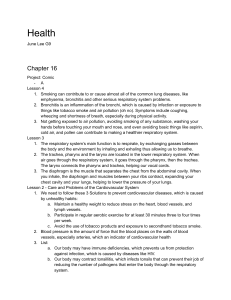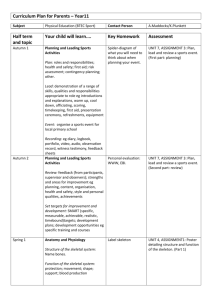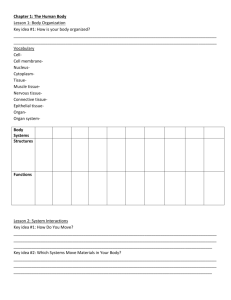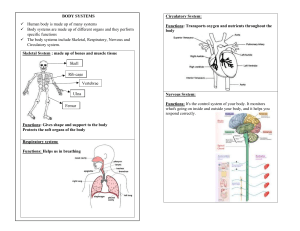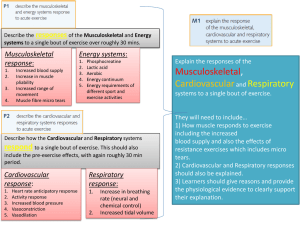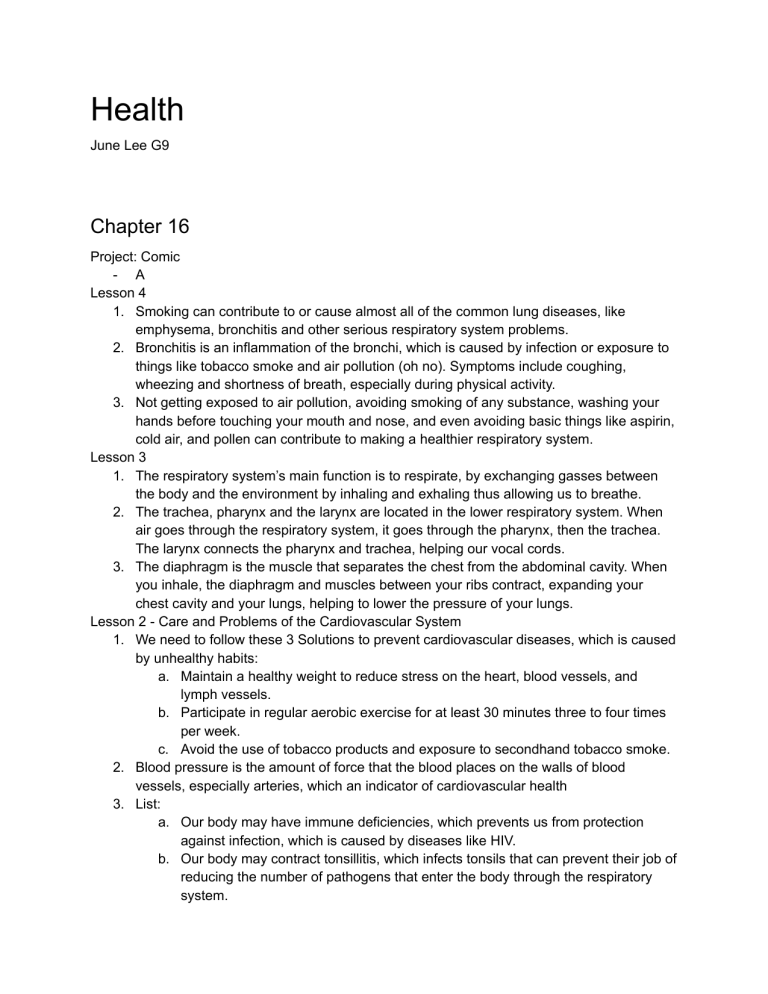
Health June Lee G9 Chapter 16 Project: Comic - A Lesson 4 1. Smoking can contribute to or cause almost all of the common lung diseases, like emphysema, bronchitis and other serious respiratory system problems. 2. Bronchitis is an inflammation of the bronchi, which is caused by infection or exposure to things like tobacco smoke and air pollution (oh no). Symptoms include coughing, wheezing and shortness of breath, especially during physical activity. 3. Not getting exposed to air pollution, avoiding smoking of any substance, washing your hands before touching your mouth and nose, and even avoiding basic things like aspirin, cold air, and pollen can contribute to making a healthier respiratory system. Lesson 3 1. The respiratory system’s main function is to respirate, by exchanging gasses between the body and the environment by inhaling and exhaling thus allowing us to breathe. 2. The trachea, pharynx and the larynx are located in the lower respiratory system. When air goes through the respiratory system, it goes through the pharynx, then the trachea. The larynx connects the pharynx and trachea, helping our vocal cords. 3. The diaphragm is the muscle that separates the chest from the abdominal cavity. When you inhale, the diaphragm and muscles between your ribs contract, expanding your chest cavity and your lungs, helping to lower the pressure of your lungs. Lesson 2 - Care and Problems of the Cardiovascular System 1. We need to follow these 3 Solutions to prevent cardiovascular diseases, which is caused by unhealthy habits: a. Maintain a healthy weight to reduce stress on the heart, blood vessels, and lymph vessels. b. Participate in regular aerobic exercise for at least 30 minutes three to four times per week. c. Avoid the use of tobacco products and exposure to secondhand tobacco smoke. 2. Blood pressure is the amount of force that the blood places on the walls of blood vessels, especially arteries, which an indicator of cardiovascular health 3. List: a. Our body may have immune deficiencies, which prevents us from protection against infection, which is caused by diseases like HIV. b. Our body may contract tonsillitis, which infects tonsils that can prevent their job of reducing the number of pathogens that enter the body through the respiratory system. Lesson 1 - The Cardiovascular System 1. The cardiovascular system circulates blood, by pumping blood and transporting them to cells to nourish them, as well as sustaining the internal environment. 2. Arteries are blood vessels that carry blood away from the heart. Capillaries are small vessels that carry blood between arterioles and venules. Veins are blood vessels that return blood to the heart. 3. Lymphs are clear fluids that fill the spaces around body cells, consisting of water and proteins,as well as lymphocytes. Lymphocytes are specialized white blood cells that provide the body with immunity and protect the body against pathogens, with most being B cells or T cells. Chapter 15 Chapter 15 Review - Lesson 1 1. Axial skeleton 2. Appendicular skeleton 3. Ligament 4. Tendon - Lesson 2 5. False. Osteoporosis 6. False. Scoliosis - Lesson 3 7. Smooth muscles 8. Cardiac muscle 9. Muscle tone 10. Hernia - Lesson 4 11. The brain stem is a stalk of nerve cells and fibers that connects the spinal cord to the rest of the brain. The second largest part of the brain is the cerebellum. The cerebrum is the largest and most complex part of the brain. Brain stem 12. Cerebellum 13. Brain Stem - Lesson 5 14. A disorder of the nervous system that is characterized by recurrent seizures is epilepsy 15. Cerebral palsy is a group of nonprogressive neurological disorders that are the result of damage to the brain before, during, or just after birth. Lesson 5 - Care and Problems of the Nervous System 1. In order to protect your head and spine, we must check how deep the water is (so we don’t die after diving into a 1 foot deep pond), and see if any logs or rocks are near the water, to ensure your head doesn’t crash into a hard object and face serious injury. 2. While a concussion is a very brief moment of unconsciousness, a coma occurs when a major trauma in the brain causes a person to go unconscious (without them being able to wake up). 3. Multiple sclerosis destroys the myelin sheath that protects the neurons and axons (that help our nervous system), and can prevent us from controlling our muscles or lose nerve functions. Lesson 4 - The Nervous System 1. It controls activity of the nervous system, helps process messages, coordinate muscle movements, like mathematical problems and learning the Chemistrian language 2. Neurons are nerve cells that transmit messages from the spinal cord and brains 3. Reflexes are spontaneous response of the body to a stimulus, like your muscle pulling your hand from a stove when you touch it because of your reflex 👍 Lesson 3 - The Muscular System 1. The cardiac muscle helps the cardiovascular system pump blood; the smooth muscles help the respiratory system to breathe; it also helps the digestive system digest; skeletal muscles help us do voluntary movements like walking and doing activities. 2. It is the striated muscle that forms the wall of the heart that helps the heart beat and pump blood 3. Tendonitis occurs when the tendon is inflamed. It can be caused by overuse, aging, or injury Lesson 2 - Care and Problems of the Skeletal System 1. You can drink milk and other foods that have vitamin D, calcium and phosphorus. You can also do light exercise like walking to strengthen your bones. If doing more tough sports, wearing protective gear and clothing can keep your bones healthy. 2. Unless you are a terrible friend, you must advise them to go to the hospital because it can get worse if not and cause further injury. 3. Repetitive motion injury is when your tissues are damaged due to excessive amounts of repetitive motion, especially with your wrist, like office work and sewing. Wearing a splint, taking medication and even surgery can help fix or prevent repetitive motion injury, though taking rests in work might also be effective. Lesson 1 - The Skeletal System 1. The skeletal system provides a structure and framework for our body so we can move and do essential functions like moving and exercising. 2. Cartilages are flexible and connective tissues that serve as both a cushion for some joints and a template from which bones can form, get repaired and renewed, like a barrier in a construction site. Ossification is this process, where the bones form, get renewed, and get repaired. 3. Ball-and-socket joints allow the most movement out of all joints, and it includes the hip joint. Hinge joints can rotate and include the knee. Pivot joints have limited rotation, and includes the rotation of the head (the neck joint, if I am correct). Ellipsoidal joints include the wrist.
